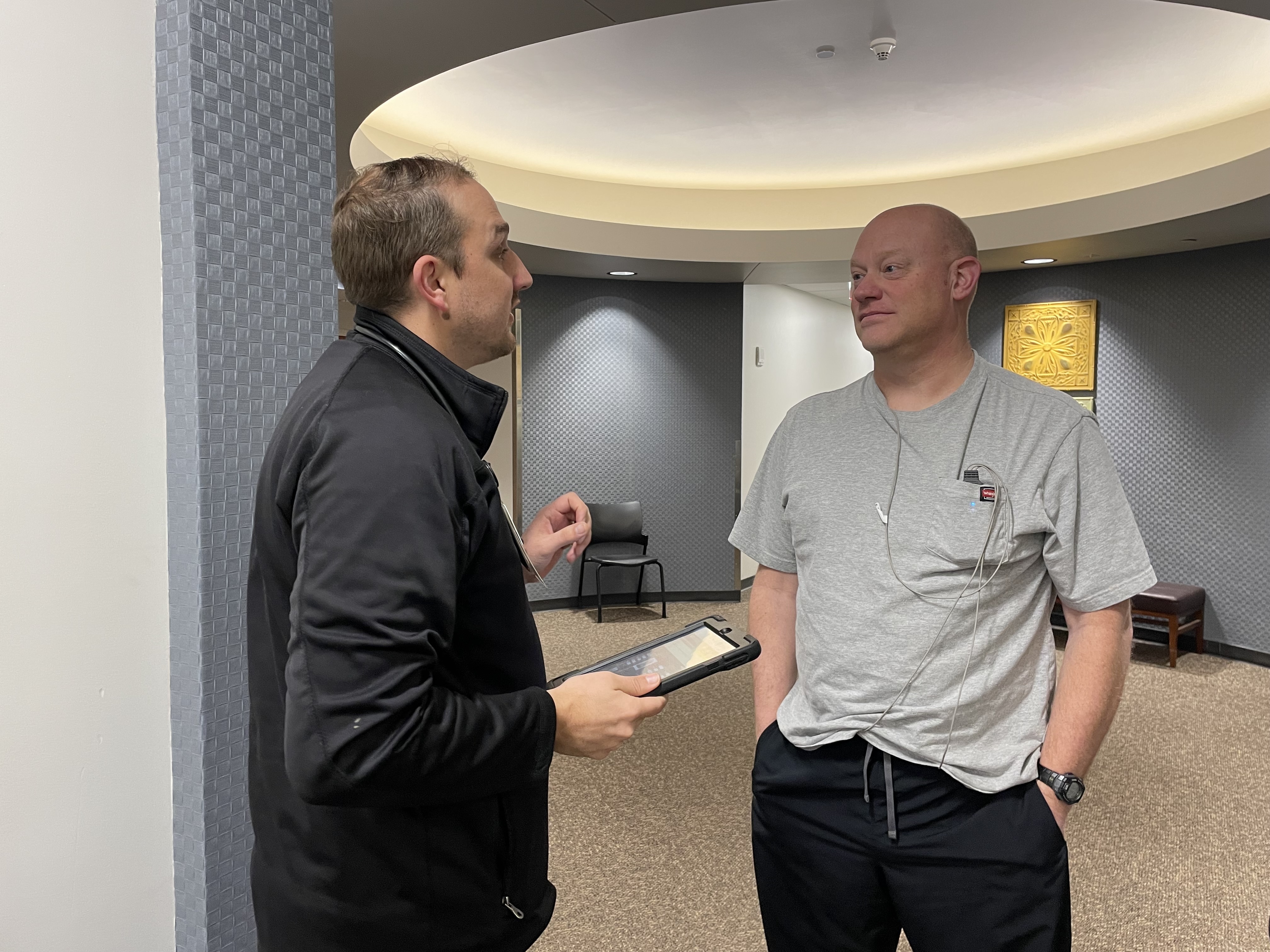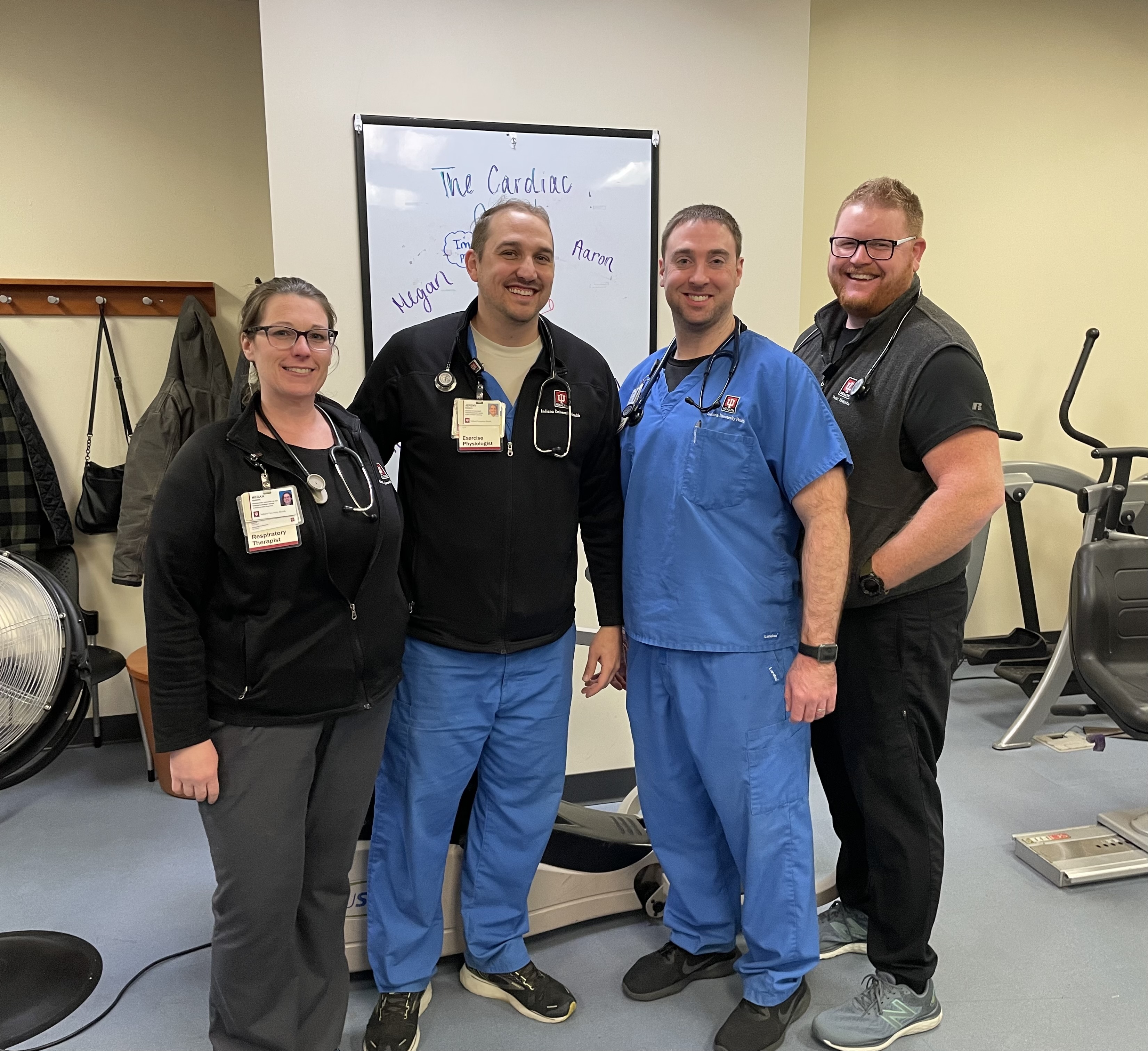While experiencing a heart attack out in the woods, firefighter Thad Dolzall knew he needed to reach a STEMI lab. After months of working with the IU Health West cardiac team, he’s back on his feet.
Written by Charlotte Stefanski, cstefanski@iuhealth.org, writer for IU Health’s Indianapolis Suburban Region
The day after Thanksgiving, Thad Dolzall and his two teenage sons made their way into the woods for an afternoon of hunting.
After lunch, the three decided to split up, with the boys going one way and Dolzall another. He told them to meet back at his truck a little after dark. That’s when Dolzall began to notice a little heartburn, but he figured it would disappear once he got up and moving.
But as he got further out into the woods, it became worse. He tried laying down to find some comfort, but now, his stomach hurt too much for him to stand up.
The 50-year-old firefighter thought maybe he could get back to his truck, go into town and buy some medicine before nightfall.
“While I’m lying there, my arm started tingling and my back started hurting,” Dolzall explained. “So I knew it—I was having a heart attack.”
Somehow, Dolzall made it back through the woods, over a creek and back to his truck. As he was unloading his gun, he felt himself beginning to blackout.
“I was standing up but my eyes literally went black,” he said. “I thought, ‘Man, I’m not even going to get out of here alive.’”
Dolzall knew he was in trouble. He was hunting deep in the woods between Spencer and Cloverdale, taking logging roads to get to his destination. Even if he had cell phone service to call 911, he had no way to pinpoint where he was.
He texted his sons—hoping it would reach them—and told them to run back to the truck. He got inside and leaned on the horn. When they arrived, Dolzall was in so much pain that he couldn’t speak. He knew he had to get to a main road to call for help.
But the more he thought about it, Dolzall knew he would have to take himself. It was the day after a major holiday, and he didn’t have enough time to wait for a volunteer crew. And being a firefighter with the Brownsburg Fire Department, he knew he needed immediate cardiac care in a STEMI lab.
The closest was IU Health West Hospital.
“I knew I was racing against time and I knew there wasn’t anywhere else to go,” Dolzall said. “I decided to take the chance to drive in myself.”
A miracle he made it
Luckily, traffic was clear and Dolzall made it to West’s Emergency department (ED) quickly. He walked in, explained the situation and was quickly placed in a room.
He wasn’t in there for very long though. Within minutes, he went into V-Fib, the most common deadly arrhythmia. Team members resuscitated him and used a defibrillator to bring him back.
Dr. Ibrahim Abu Romeh, an interventional cardiologist at IU Health West, was on call that day.
“When Thad came in, our team was activated,” Abu Romeh explained. “That’s what we call it when everybody is called in for an emergency.”
Dolzall was then taken to the catheterization lab where Abu Romeh opened up his artery and placed a stent to relieve the pain and restore blood to the heart muscle.
He had experienced an ST-elevation myocardial infarction (STEMI), a type of severe heart attack caused by a 100% blockage of a coronary artery.
“Heart attacks are always major. People can unfortunately have abnormal rhythms that can be life threatening, which can cause cardiac arrest sometimes,” Abu Romeh said. “If he hadn’t come in that quick, he could have had a sudden cardiac arrest or another unfavorable outcome.”
Dolzall was awake throughout the entire procedure. He remembers everything from the elevator ride up to the lab to feeling the stent being placed.
“Team members had a sense of urgency too. I remember Dr. Abu Romeh talking to me when I was going through the whole thing, explaining what they’re going to do,” Dolzall said. “I could see the procedure on the monitor. You can feel the catheter go up, you can feel that in your heart. It wasn’t painful, but you can feel it.”
From there, Dolzall was taken to the hospital’s Intensive Care unit (ICU). He stayed there for three days to heal and battle breathing difficulties and pneumonia.
“I knew how serious my situation was. It was just one of those things where they had done everything they could do,” Dolzall said. “They told me what was going on and kept me informed.”
Healing with cardiac rehab
One of those team members was Jeremy Kimbley, an exercise physiologist and team lead of IU Health West’s Cardiac Rehab program.
Kimbley visited Dolzall while he was resting in the ICU, simply to introduce himself and to explain what the program entails.
Cardiac rehab is a beneficial part of the healing process and is strongly recommended after a heart attack or stent placement. It not only allows patients to exercise in a supervised environment where their heart levels are monitored, but team members also help patients with dietary changes and smoking cessation.
The program is catered to each patient’s needs, and Dolzall’s heart attack caused problems with the functionality of his heart, meaning his heart wasn’t squeezing as tightly as it should.
“With everything we do from a cardiovascular perspective—with medication, diet and exercise—we are trying to increase a patient’s functional capacity, which is how much work an individual is able to perform with lack of symptoms,” Kimbley explained.

The team also took into account that Dolzall is a firefighter, which often means periods of high intensity work followed by periods of low intensity.
Because of this, a more high intensity regimen was created, starting out with two minutes of running, followed by three of walking, on repeat.
“I tell patients that my goal is to get them back to doing the things they were doing before they had a heart attack, without having concern that their heart is going to be an issue,” Kimbley said.
A bit of hope
After being released from the ICU, Dolzall was scheduled to begin cardiac rehab two weeks later. During their first session, the two sat down and tried to figure out why the heart attack had happened and how to prevent another.
“Jeremy asked me what my goal was, and I told him my goal was that I wanted to go back to work and be a firefighter. I wasn’t sure that would ever happen, I’ll be honest,” Dolzall said. “I knew I had a very serious heart attack and had died, literally. But we sat down, we made a plan.”
Any heart attack is considered a life changing event, Abu Romeh said, which means caretakers need to figure out how to modify the risk factors that increase the risk for heart attacks, including improving dietary habits, encouraging exercise and stopping smoking. Kimbley adds that sometimes it’s things that can’t be controlled, including family history, age, gender or race.
While Dolzall had no family history of heart problems, he did have a poor diet, which was the cause of his heart attack. The idea of rehab was scary, as he still felt weak and exhausted.
“Going into rehab, you’re afraid that if you do anything, that you’ll just drop dead,” Dolzall said.
He isn’t alone in that, and Kimbley said patients often have mental hurdles to overcome after a cardiac episode. His team isn’t there for just the physical aspects, but they help with the mental challenges too.
Despite being nervous about his first appointment, Dolzall said it was like a flip of a switch. He felt alive again, he could feel blood flowing, and he had so much energy he could barely sleep that night.

Dolzall attended cardiac rehab three times a week, and with every appointment, he kept getting stronger. Those two-to-three minute intervals changed to five minute intervals. Most importantly, he started to have hope again.
“The cardiac team saved my life, no doubt about it. I’m telling you, I would have died. In fact, I did die and they brought me back,” Dolzall said. “But with rehab, I went from just being alive to living—to getting back to normal, to doing the things I want to do. Now, I feel normal. I don’t feel like anything ever happened.”
Getting back to normal
After months of rehab, Dolzall reached his goal—He graduated from the program on Feb. 13 and went back to his firefighting duties on Feb. 22.
He thanks all of the IU Health West team members who helped save his life, whether they be in the ED, cath lab, ICU or cardiac rehab team.
“I owe them a lot. I’m so thankful,” he said. “They really changed my life. They saved my life. All of them did.”
To prevent another cardiac event, Dolzall has drastically changed his diet and added more exercise in his life. After his procedure, he’s noticed how much energy he has. Even at 51, he feels 20 years younger. He didn’t realize how bad he was feeling until the procedure. His wife and sons are also happy to see him back on track.
Looking back, the only time he ever had a symptom before his heart attack was the week before. It was the same feeling that started in the woods.
“If you feel like your body is limiting you in any way, go get that fixed, because it shouldn’t. I don’t care how old you are—pay attention to that,” Dolzall advised. “If you ever have anything going on that doesn’t feel right, just go get it checked out. It’s the inconvenience of that compared to what most people wouldn’t live through, what I did live through.”
“If you ask me what happened? First of all, God saved my life. But I feel like he told me where to go for help. I wouldn’t have wanted to go anywhere else,” Dolzall added. “I think IU Health West has got their act together. They really do. Everybody was so kind and there’s no exception to that. That matters.”
Keep heart health in mind
February is American Heart Month and prevention is key.
Both Abu Romeh and Kimbley stress that if you’re experiencing any heart symptoms, including shortness of breath and chest tightness or pain, to have it evaluated immediately.
Heart health is also heavily impacted by diet and exercise, as well as risk factors like smoking and drinking.
“Oftentimes, we hear so many times patients say, ‘I’ve been having shortness of breath for six months,’ or, ‘I had chest discomfort when I was out cutting the grass,’ and ignored it,” Kimbley said. “The key to a lot of heart problems is time. If you can catch it early before it turns into a heart attack, that’s very important. Make sure that you’re being honest and talking to your doctors about the symptoms.”
